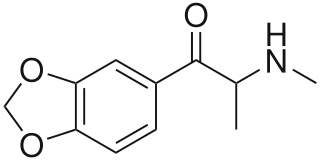 | |
| Legal status | |
|---|---|
| Legal status |
|
| Identifiers | |
| |
| CAS Number |
|
| PubChem CID | |
| ChemSpider | |
| UNII |
|
| CompTox Dashboard (EPA) | |
| Chemical and physical data | |
| Formula | C17H23NO2 |
| Molar mass | 273.376 g·mol−1 |
| 3D model (JSmol) | |
| |
| |
5-DBFPV (also known as 5-dihydro
 | |
| Legal status | |
|---|---|
| Legal status |
|
| Identifiers | |
| |
| CAS Number |
|
| PubChem CID | |
| ChemSpider | |
| UNII |
|
| CompTox Dashboard (EPA) | |
| Chemical and physical data | |
| Formula | C17H23NO2 |
| Molar mass | 273.376 g·mol−1 |
| 3D model (JSmol) | |
| |
| |
5-DBFPV (also known as 5-dihydro
5-DBFPV is illegal in Sweden as of 26. January 2016. [6]
It's likely that 5-FDBFPV can apply under the federal analogue act if used for human consumption as it is an analog of Methylenedioxypyrovalerone.

Methylone, also known as 3,4-methylenedioxy-N-methylcathinone (MDMC), is an empathogen and stimulant psychoactive drug. It is a member of the amphetamine, cathinone and methylenedioxyphenethylamine classes.

Methylenedioxypyrovalerone is a stimulant of the cathinone class that acts as a norepinephrine–dopamine reuptake inhibitor (NDRI). It was first developed in the 1960s by a team at Boehringer Ingelheim. Its activity at the dopamine transporter is six times stronger than at the norepinephrine transporter and it is virtually inactive at the serotonin transporter. MDPV remained an obscure stimulant until around 2004 when it was reportedly sold as a designer drug. In the US, products containing MDPV and labeled as bath salts were sold as recreational drugs in gas stations, similar to the marketing for Spice and K2 as incense, until it was banned in 2011.

α-Pyrrolidinopropiophenone (α-PPP), is a stimulant drug. It is similar in structure to the appetite suppressant diethylpropion and has analogous effects in animals. Little is known about this compound, but it has been detected by laboratories in Germany as an ingredient in "ecstasy" tablets seized by law enforcement authorities. This drug has been found to produce stimulant effects in animals and produces highly stimulating effects in humans, based on the experiences of the individuals who have tried it. Most of the individuals who have tried it prefer α-PVP to it, but prefer this drug over α-PVT. It is said to lack euphoria compared to α-PVP.

The substituted methylenedioxyphenethylamines represent a diverse chemical class of compounds derived from phenethylamines. This category encompasses numerous psychoactive substances with entactogenic, psychedelic, and/or stimulant properties, in addition to entheogens. These compounds find application as research chemicals, designer drugs, and recreational substances.

3',4'-Methylenedioxy-α-pyrrolidinobutyrophenone (MDPBP) is a stimulant of the cathinone class developed in the 1960s, which has been reported as a novel designer drug. MDPBP is sometimes sold under the name "NRG-1" as a mixture with other cathinone derivatives, including flephedrone, pentylone, MαPPP and its higher homologue MDPV. As with other cathinones, MDPBP has been shown to have reinforcing effects in rats.

α-Pyrrolidinopentiophenone (α-PVP), also known as α-pyrrolidinovalerophenone, O-2387, β-keto-prolintane, prolintanone, or desmethylpyrovalerone, is a synthetic stimulant of the cathinone class developed in the 1960s that has been sold as a designer drug and often consumed for recreational reasons. α-PVP is chemically related to pyrovalerone and is the ketone analog of prolintane.

Naphyrone, also known as O-2482 and naphthylpyrovalerone, is a substituted cathinone drug derived from pyrovalerone that acts as a serotonin–norepinephrine–dopamine reuptake inhibitor (SNDRI), producing stimulant effects and has been reported as a novel designer drug. No safety or toxicity data is available on the drug.

Substituted cathinones, or simply cathinones, which include some stimulants and entactogens, are derivatives of cathinone. They feature a phenethylamine core with an alkyl group attached to the alpha carbon, and a ketone group attached to the beta carbon, along with additional substitutions. Cathinone occurs naturally in the plant khat whose leaves are chewed as a recreational drug.

α-Pyrrolidinohexiophenone is a synthetic stimulant drug of the cathinone class developed in the 1960s which has been reported as a novel designer drug.

4'-Methoxy-α-pyrrolidinopentiophenone is a stimulant drug of the cathinone class that has been sold online as a designer drug.

3',4'-Dimethoxy-α-pyrrolidinopentiophenone is a synthetic stimulant drug of the cathinone class that has been sold online as a designer drug. It is a relatively weak inhibitor of serotonin reuptake and has little affinity in vitro for dopamine or noradrenaline transporters.

4'-Fluoro-α-pyrrolidinopentiophenone is a stimulant drug of the cathinone class which has been reported as a novel designer drug.

Indapyrophenidone is a synthetic drug of the cathinone class that has been sold online as a designer drug.

N-Ethylhexedrone (also known as α-ethylaminocaprophenone, N-ethylnorhexedrone, hexen, and NEH) is a stimulant of the cathinone class that acts as a norepinephrine–dopamine reuptake inhibitor (NDRI) with IC50 values of 0.0978 and 0.0467 μM, respectively. N-Ethylhexedrone was first mentioned in a series of patents by Boehringer Ingelheim in the 1960s which led to the development of the better-known drug methylenedioxypyrovalerone (MDPV). Since the mid-2010s, N-ethylhexedrone has been sold online as a designer drug. In 2018, N-ethylhexedrone was the second most common drug of the cathinone class to be identified in Drug Enforcement Administration seizures.

Hexadrone is a stimulant of the substituted cathinone class which has been sold as a designer drug. Through analysis of the Structure-Activity Relationships in similar cathinones such as MDPV, hexedrone is believed to be a norepinephrine–dopamine reuptake inhibitor.

3-Chloromethcathinone (3-CMC), also known as clophedrone, is a synthetic substance belonging to the cathinone class of psychoactive compounds. It is very similar in structure to other methcathinone derivatives such as 3-MMC and 4-CMC. Unlike cathinone, which occurs naturally in the khat plant Catha edulis, 3-CMC is not found in nature and is solely produced through chemical synthesis.

α-Pyrrolidinoisohexanophenone is a stimulant drug of the cathinone class that has been sold online as a designer drug. It acts as a potent norepinephrine-dopamine reuptake inhibitor (NDRI). In July 2016 α-PiHP was first identified as a designer drug when it was reported to the EMCDDA by a forensic laboratory in Slovenia. It is a positional isomer of pyrovalerone, with the methyl group shifted from the 4-position of the aromatic ring to the 4-position of the acyl chain. Similarly to other cathinones, use of α-PiHP can result in compulsive redosing, addiction, anxiety, paranoia, and psychosis.

TH-PVP is a substituted cathinone derivative which has been sold as a designer drug. It was first identified by a forensic laboratory in Hungary in 2015, but has subsequently been found in numerous other countries around the world including Spain, Belgium, Poland, Turkey and Brazil.

O-2390 is a recreational designer drug from the substituted cathinone family, which acts as a potent inhibitor of dopamine and noradrenaline reuptake in vitro, with weaker but still significant inhibition of serotonin reuptake.